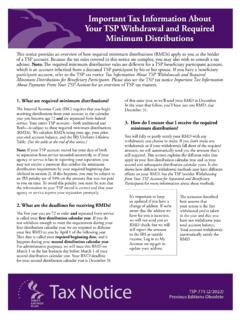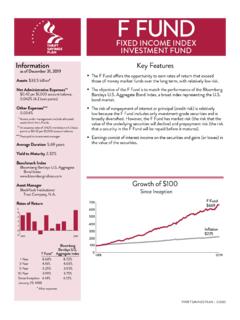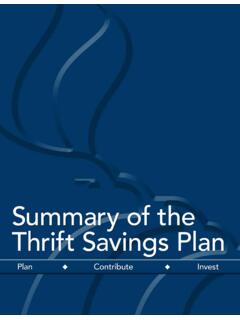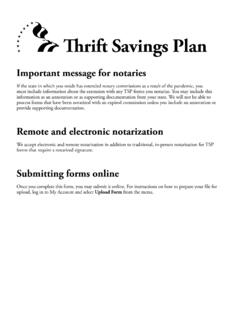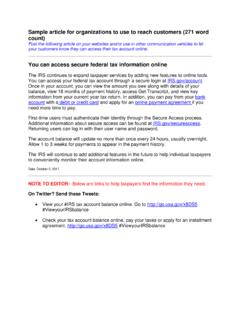Transcription of Tax Information: Death Benefit Payments
1 Tax NoticeTSP-583 (10/2015)Previous Editions ObsoleteImportant Tax Information About Thrift Savings Plan Death Benefit Payments1. General Tax InformationThe tax treatment of a Thrift Savings Plan Death Benefit payment depends on the type of money contributed to the TSP account. A TSP account may consist of a traditional (non-Roth) balance , a Roth balance , or to a traditional (non-Roth) balance are made pre-tax. This means that the participant did not pay taxes on his or her own contributions, any agency contri-butions, or earnings. Therefore, taxes will be owed on the traditional (non-Roth) portion of a Death Benefit payment. Contributions to a Roth balance are made after-tax. This means that the participant paid tax on his or her contribu-tions before those contributions were made.
2 Any amount of a Death Benefit payment that is made up of Roth contri-butions is not taxable. The Roth earnings portion of a Death Benefit payment is qualified ( , paid tax-free) if 5 years have passed since January 1 of the year the participant made his or her first Roth contribution. Note: All Death Benefit Payments will be disbursed pro rata ( , proportionally) from any traditional (non-Roth) and Roth balances in the deceased participant s TSP Income Tax Withholding and ReportingThe TSP must withhold for Federal income tax from tax-able Death Benefit Payments we make unless a beneficiary transfers the payment to an inherited IRA (see Section 3).The chart below describes the withholding rates and op-tions available to recipients of Death Benefit Payments from Before you receive a Death Benefit payment from the Thrift Savings Plan (TSP), you should review the important information in this notice.
3 Although the TSP can assist you in receiving your payment, we cannot provide tax advice. Because tax rules are complex and are determined based on the recipient of the payment, you may wish to speak with a tax advisor before you make any decisions that might have tax consequences. Note: A beneficiary participant account is automatically established for a spouse beneficiary who inherits $200 or more from a civilian or uniformed services TSP account. The specific tax rules for withdrawals from beneficiary participant accounts are summarized in the TSP tax notice Important Tax Information About Payments From Your TSP Account. Type of TSP PaymentType of Payment for IRS PurposesMay I Transfer or Roll Over the Payment?
4 What Is the Federal Withholding Rate?1 May I Increase Withholding?May I Decrease Withholding?May I Waive Withholding? Death Benefit payment to a nonspouse or trust from a civilian or uniformed services TSP account2 Eligible rollover distributionMay only be trans-ferred into an inher-ited IRA. Rollovers are not (unless transferred)Yes. Complete line 3 of IRS Form Benefit payment to an estate, corporation, or other legal entity from a civilian or uniformed serv- ices account2 Non-periodic paymentNo10%Yes. Complete line 3 of IRS Form Complete line 1 of IRS Form W-4P. 3 Death Benefit payment to a beneficiary (spouse, nonspouse, trust, corpora-tion, legal entity, or estate) from a beneficiary partici-pant account4 Non-periodic paymentNo10%Yes.
5 Complete the appropriate section of the Request for Immediate Pay-ment Complete the appropriate section of the Request for Immediate Pay-ment Applies to Payments of $200 or more received in a single year and only to the taxable portion of the payment ( , the earnings portion of a nonqualified Roth distribution). Your payment may also be subject to state income A Death Benefit payment is not made to a spouse who inherits $200 or more from a civilian or uniformed services TSP account. Instead, a beneficiary participant account is established in the spouse s If you are receiving Death Benefit Payments from more than one type of TSP account, you must submit a separate form for each type of A beneficiary participant account is one that was inherited by the spouse of a deceased TSP types of TSP accounts.
6 If you believe the standard withholding amount will not be sufficient to cover your full Federal tax liability, you may request additional withhold-ing. To change the standard withholding, you must file IRS Form W-4P, Withholding Certificate for Pension or Annuity Payments , with the TSP, or complete the appropriate section of the Request for Immediate Payment form (for Payments made from beneficiary participant accounts only) before the Death Benefit payment is disbursed. The TSP reports all TSP distributions to the IRS and to you, on IRS Form 1099-R, Distributions From Pensions, An-nuities, Retirement or Profit-Sharing Plans, IRAs, Insurance Contracts, Transferring to an Inherited IRAThe Internal Revenue Code (IRC) allows nonspouse benefi-ciaries, including trusts (but not estates), of civilian and uni-formed services TSP accounts to transfer all or part of a Death Benefit payment to an inherited IRA.
7 A trust must satisfy the conditions specified in Treas. Reg. (a)(9)-4, Q&A 5. An inherited IRA is an IRA established specifically for the purpose of transferring money inherited from a plan such as the TSP. Inherited IRAs may provide significant tax benefits since the required distribution for the IRA can generally be spread across the lifetime of the beneficiary. However, the rules governing inherited IRAs are complicated, and there are restrictions. So before you make a decision to transfer money from the TSP to such an IRA, we strongly recommend that you discuss the details of your transfer with a qualified tax advisor or your IRA provider. You may not roll over ( , receive the money from the TSP and put it into an IRA or other plan yourself ) a TSP Death Benefit paid directly to you choose to have the TSP transfer all or part of the pay-ment to an inherited IRA: Your transfer will not be taxed in the current year, and no income tax will be withheld.
8 The taxable portion of your payment will be taxed when you withdraw it from the inherited IRA. The tax treatment and plan rules for withdrawals from the inherited IRA to which you transfer the distribu-tion may be different from those of the : Death benefits paid from a beneficiary participant account cannot be transferred into an inherited IRA. Instead the payment will be made directly to the beneficiary of the beneficiary participant account. 4. Special Note Regarding Tax-Exempt MoneyTSP accounts for members of the uniformed services and the beneficiary participant accounts that result from them may include contributions from pay that is subject to the combat zone tax exclusion. Those contributions are tax-ex-empt and remain tax-exempt when a participant dies and the money is inherited.
9 However, the earnings on tax-exempt contributions may or may not be taxable. Earnings on tax-exempt contributions made to a traditional (non-Roth) balance are taxable when they are distributed. But earnings on tax-exempt contribu-tions made to a Roth balance are not taxable if they satisfy the IRS rules for qualified earnings (see Section 1).If you receive a payment from an account that has tax-exempt contributions, the TSP will report the tax-exempt portion separately on IRS Form : Death Benefit Payments from traditional balances that contain both taxable and tax-exempt money will be paid proportionally from taxable and nontaxable amounts. If a payment is eligible to be transferred to an inherited IRA, any TSP tax-exempt contributions may also be transferred if the inherited IRA certifies that it will accept tax-exempt con-tributions.
10 If the inherited IRA does not accept tax-exempt money, the tax-exempt funds will be paid directly to you. 5. Ten-Year Tax OptionIf the participant was born before January 2, 1936, you may be eligible to calculate the amount of the tax on the Death Benefit payment by using the 10-year tax option, which will often reduce the tax you owe. To learn more, see IRS Publi-cation 575, Pension and Annuity Income, and IRS Form 4972, Tax on Lump Sum Distributions. The 10-year tax option does not apply to Death Benefit Payments made from benefi-ciary participant accounts. 6. Rules for Nonresident Aliens and Their BeneficiariesIf you are a nonresident alien and you do not have the TSP transfer your payment to a inherited IRA, the TSP is generally required to withhold 30% (instead of 20%) of the payment for Federal income taxes.

